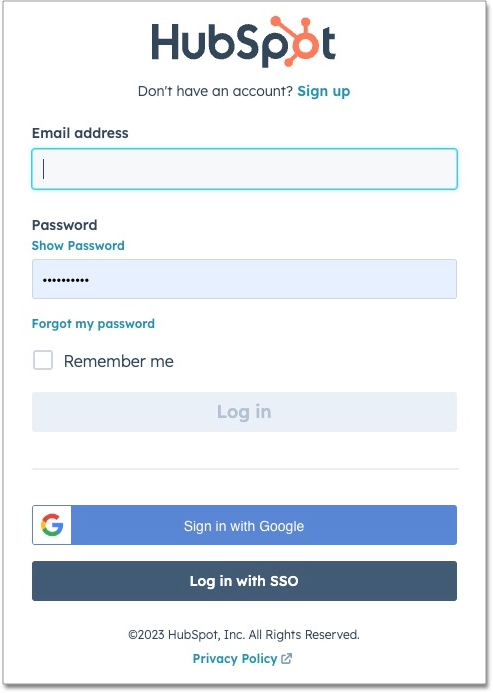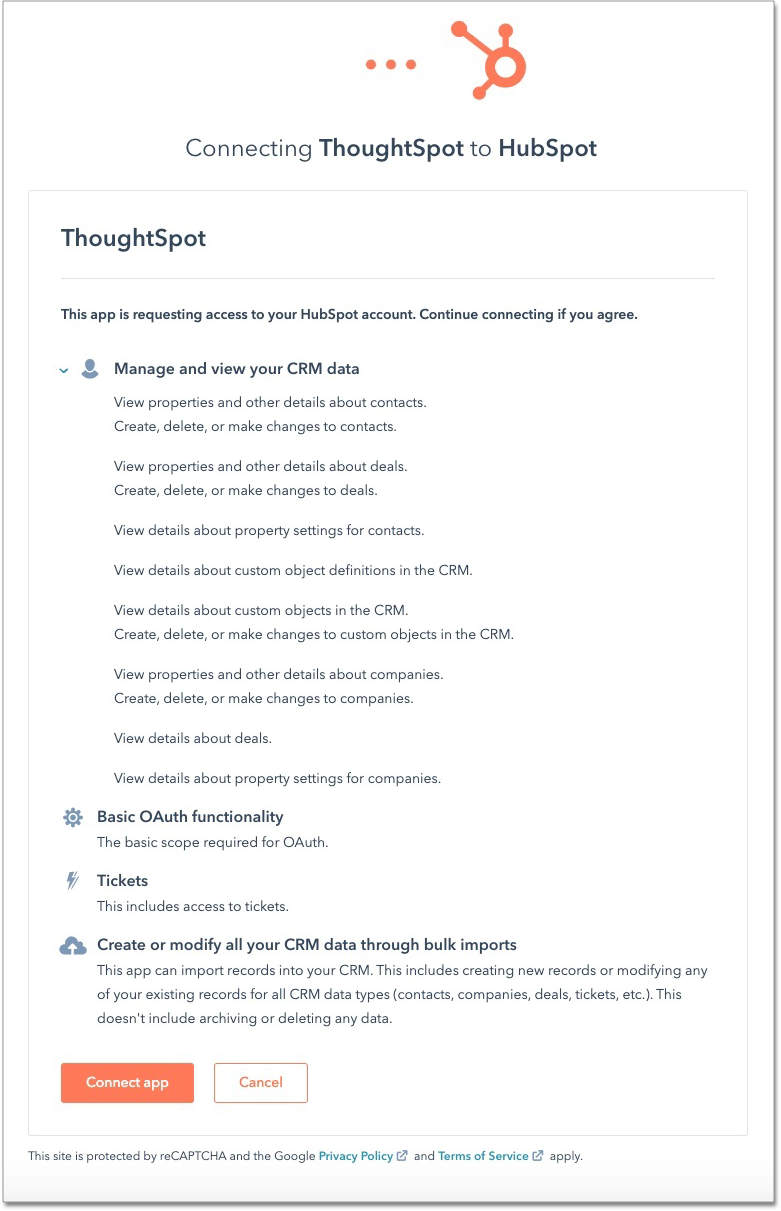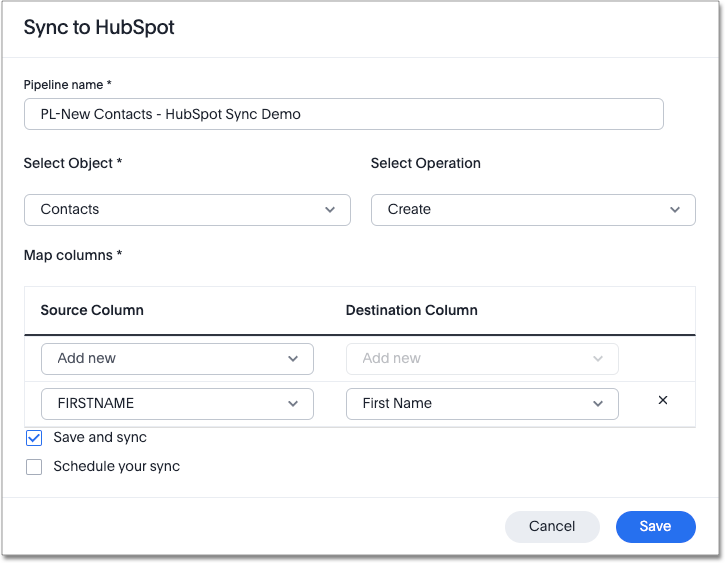Sync data from ThoughtSpot to HubSpot
Sync to HubSpot from an Answer
To create a sync to HubSpot from an Answer, follow these steps:
-
Select the desired Answer from the Answers tab or the ThoughtSpot homepage. You must have Can manage sync permissions and view access to an Answer to create a sync.
-
In the upper-right corner of the Answer, click the more options menu icon
 . From the dropdown menu, select Sync to other apps, then choose HubSpot.
. From the dropdown menu, select Sync to other apps, then choose HubSpot. -
If this is the first sync you have created for HubSpot, a pop-up authorization window appears. To give ThoughtSpot permission to send data to your HubSpot account, sign in to your account in the pop-up window and click Connect app.


-
Within ThoughtSpot, fill in the following parameters:
-
Edit the Pipeline name if needed. By default, this field populates with PL-[Answer Name].
-
If you have more than one HubSpot destination set up, then the Destination field appears, and you will have to select a HubSpot destination from the dropdown menu available. However, if no destinations have been set up before or if you have only one HubSpot destination, the Destination field will not appear.
-
Select your HubSpot Object from the dropdown menu. Sync to HubSpot supports four objects: Contacts, Companies, Deals, and Tickets.
-
Select Operation from the dropdown menu. You can choose between Create, Update, and Delete.
-
Map the Source and Destination columns from the dropdown menus provided. Note that the Source column refers to the column in ThoughtSpot, while the Destination column refers to the column in HubSpot. You can now use email as a mapping column for Contacts objects, as well as ContactID.

-
-
By default, "Save and sync" is selected. Select Save to send your data to HubSpot. Your data immediately appears in HubSpot.
-
[Optional] To set up a repeated sync, click Schedule your sync and select your timezone. From the options provided, choose whether the sync will occur every:
-
n minutes. You can choose to schedule a sync every 5, 10, 15, 20, 30, or 45 minutes.
-
n hours.
-
n days at a selected time. Note that you can choose not to send an update on weekends.
-
week at a selected time and day.
-
n months at a selected time and date.
-
| Any sync over 50,000 rows may result in an execution timeout. For optimal performance, keep your sync to below 50,000 rows. If you’re syncing a large number of rows and the sync fails, try applying filters like date filters to make your dataset smaller and then sync. |
Sync to HubSpot from a Custom SQL View
To sync to HubSpot from a custom SQL view, follow these steps:
-
Navigate to your SQL view by selecting the Data tab and searching from the Data Workspace home page. Select the SQL view name.
-
In the upper-right corner, click the more options menu icon
 and select Sync to HubSpot.
and select Sync to HubSpot. -
If this is the first sync you have created for the selected app, an authorization page appears. To give ThoughtSpot permission to send data to your HubSpot account, sign in to your account in the pop-up window and click Connect app.
-
Fill in the following parameters:
-
Edit the Pipeline name if needed. By default, this field populates with PL-[Answer Name].
-
If you have more than one HubSpot destination set up, then the Destination field appears, and you have to select a HubSpot destination from the dropdown menu available. However, if no destinations have been set up before or if you have only one HubSpot destination, the Destination field will not appear.
-
Select Object from the dropdown menu. Sync to HubSpot supports four objects: Contacts, Companies, Deals, and Tickets.
-
Select Operation from the dropdown menu. You can choose between Create, Update, and Delete.
-
Map the Source and Destination columns from the dropdown menus provided.
-
-
By default, "Sync and save" is selected. Select Save to send your data to HubSpot. Your data immediately appears in HubSpot.
-
[Optional] To set up a repeated sync, click Schedule your sync and select your timezone. From the options provided, choose whether the sync will occur every:
-
n minutes. You can choose to schedule a sync every 5, 10, 15, 20, 30, or 45 minutes.
-
n hours.
-
n days at a selected time. Note that you can choose not to send an update on weekends.
-
week at a selected time and day.
-
n months at a selected time and date.
-
| Any sync over 50,000 rows may result in an execution timeout. For optimal performance, keep your sync to below 50,000 rows. If you’re syncing a large number of rows and the sync fails, try applying filters like date filters to make your dataset smaller and then sync. |
Sync to HubSpot from the Data Workspace
To create a sync to HubSpot from the Data Workspace, follow these steps:
-
Select the Data tab.
-
On the left menu bar, select Sync.
-
Under the Pipelines tab, select "Create new pipeline". Note that if you do not already have a destination created to the intended destination app, you first need to create one in the Destinations tab.
-
Fill in the following parameters:
-
Edit the Pipeline name if needed. By default, this field populates with PL-[Answer Name].
-
All destinations available appear in the Destination dropdown menu.
-
Select your Source data. Here you will pick an Answer or a custom SQL view to send through sync.
-
Select Object from the dropdown menu. Sync to HubSpot supports four objects: Contacts, Companies, Deals, and Tickets.
-
Select Operation from the dropdown menu. You can choose between Create, Update, and Delete
-
Map the source and destination columns from the dropdown menus provided.
-
-
By default, Save and sync is selected. Select Save to send your data to HubSpot. Your data immediately appears in HubSpot.
-
[Optional] To set up a repeated sync, click Schedule your sync and select your timezone. From the options provided, choose whether the sync will occur every:
-
n minutes. You can choose to schedule a sync every 5, 10, 15, 20, 30, or 45 minutes.
-
n hours.
-
n days at a selected time. Note that you can choose not to send an update on weekends.
-
week at a selected time and day.
-
n months at a selected time and date.
-
| Any sync over 50,000 rows may result in an execution timeout. For optimal performance, keep your sync to below 50,000 rows. If you’re syncing a large number of rows and the sync fails, try applying filters like date filters to make your dataset smaller and then sync. |
Updating and deleting records in HubSpot
To update and delete records in HubSpot,the Record Id field must be used as the mapping field. The following table shows the mapping needed for each object to update or delete records in HubSpot.
| HubSpot object | Source column | Destination column |
|---|---|---|
Contacts |
ContactID |
Record Id |
Companies |
CompanyID |
Record Id |
Deals |
DealID |
Record Id |
Tickets |
TicketID |
Record Id |
This ID can also be found at the end of the URL link when you open a contact, deal, company, or ticket. See the following example, where the contactID / Record Id has been highlighted.
https://app.hubspot.com/contacts/22693066/contact/1751 ] === Failure to sync
A sync to HubSpot can fail due to multiple reasons. If you experience a sync failure, consider the following causes:
-
The underlying ThoughtSpot object was deleted.
-
The underlying HubSpot object was deleted.
-
The column name was changed in either ThoughtSpot or HubSpot, making it different to the column name setup in the mapping.
-
There are data validation rules in HubSpot which only allow data with a certain data type to be populated in the HubSpot fields, but the columns being mapped onto HubSpot from ThoughtSpot do not have the same or allowable data type.
-
NOTE: In this case, only the rows in ThoughtSpot that meet the data validation criteria of the column in HubSpot will be inserted or updated. All others will be ignored.
-
-
There is a mandatory field in HubSpot which has not been mapped as a destination column when setting up the mapping in ThoughtSpot.
-
Any sync over 50,000 rows may result in an execution timeout. For optimal performance, keep your sync to below 50,000 rows. If you’re syncing a large number of rows and the sync fails, try applying filters like date filters to make your dataset smaller and then sync.
Manage pipelines
While you can also manage a pipeline from the Pipelines tab in the Data Workspace, accessing the Manage pipelines option from an Answer or view displays all pipelines local to that specific data object. To manage a pipeline from an Answer or view, follow these steps:
-
Click the more options menu icon
 and select Manage pipelines.
and select Manage pipelines. -
Scroll to the name of your pipeline from the list that appears. Next to the pipeline name, select the more options icon
 . From the list that appears, select:
. From the list that appears, select:-
Edit to edit the pipeline’s properties. For example, for a pipeline to Google Sheets, you can edit the pipeline name, file name, sheet name, or cell number. Note that you cannot edit the source or destination of a pipeline.
-
Delete to permanently delete the pipeline.
-
Sync now to sync your Answer or view to the designated destination.
-
View run history to see the pipeline’s Activity log in the Data Workspace.

-
Related information



